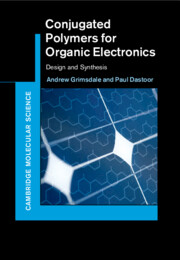Book contents
- Conjugated Polymers for Organic Electronics
- Cambridge Molecular Science
- Conjugated Polymers for Organic Electronics
- Copyright page
- Contents
- Preface
- Abbreviations
- 1 Introduction
- 2 Polyacetylenes
- 3 Poly(arylene vinylene)s
- 4 Poly(arylene ethynylene)s
- 5 Poly(phenylene)s
- 6 Polyfluorenes and Related Polymers
- 7 Polythiophenes
- 8 Other Arylene-Based Polymers
- 9 Hyperbranched Polymers, Star Polymers and Dendrimers
- 10 Polymers with Molecular-like Chromophores
- 11 Polymers for Phosphorescent LEDs
- 12 Polymers for White-Emitting PLEDs
- 13 Polymers for Other Luminescent Devices
- 14 Conclusion and Outlook
- References
- Index
8 - Other Arylene-Based Polymers
Published online by Cambridge University Press: 28 March 2024
- Conjugated Polymers for Organic Electronics
- Cambridge Molecular Science
- Conjugated Polymers for Organic Electronics
- Copyright page
- Contents
- Preface
- Abbreviations
- 1 Introduction
- 2 Polyacetylenes
- 3 Poly(arylene vinylene)s
- 4 Poly(arylene ethynylene)s
- 5 Poly(phenylene)s
- 6 Polyfluorenes and Related Polymers
- 7 Polythiophenes
- 8 Other Arylene-Based Polymers
- 9 Hyperbranched Polymers, Star Polymers and Dendrimers
- 10 Polymers with Molecular-like Chromophores
- 11 Polymers for Phosphorescent LEDs
- 12 Polymers for White-Emitting PLEDs
- 13 Polymers for Other Luminescent Devices
- 14 Conclusion and Outlook
- References
- Index
Summary
This chapter discusses how to tune the orbital energy levels and bandgaps of copolymers containing arylene and/or heteroarylene units, so as to obtain materials for high efficiency LEDs, TFTs and OPVs. By careful selection of the structures, and optimisation of the molar masses, polymers have been made which show very high charge carrier mobilities due to efficient charge transport. Here control of the solid-state packing is important but high crystallinity does not seem to be necessary. Transistors can be made with mobilities superior to that of amorphous silicon, though their commercial viability remains unproven. Careful control of bandgaps, molar masses and solid-state order combined with the development of new acceptor molecules has led to the fabrication of OPV devices with efficiencies close to 20%, which is better than many commercial solar cells. The commercial viability of OPVs remains to be demonstrated with device lifetimes still needing improvement, but these results combined with the low cost of making and processing conjugated polymers suggests such devices could be competitive with current ones with further optimisation.
- Type
- Chapter
- Information
- Conjugated Polymers for Organic ElectronicsDesign and Synthesis, pp. 117 - 148Publisher: Cambridge University PressPrint publication year: 2024



